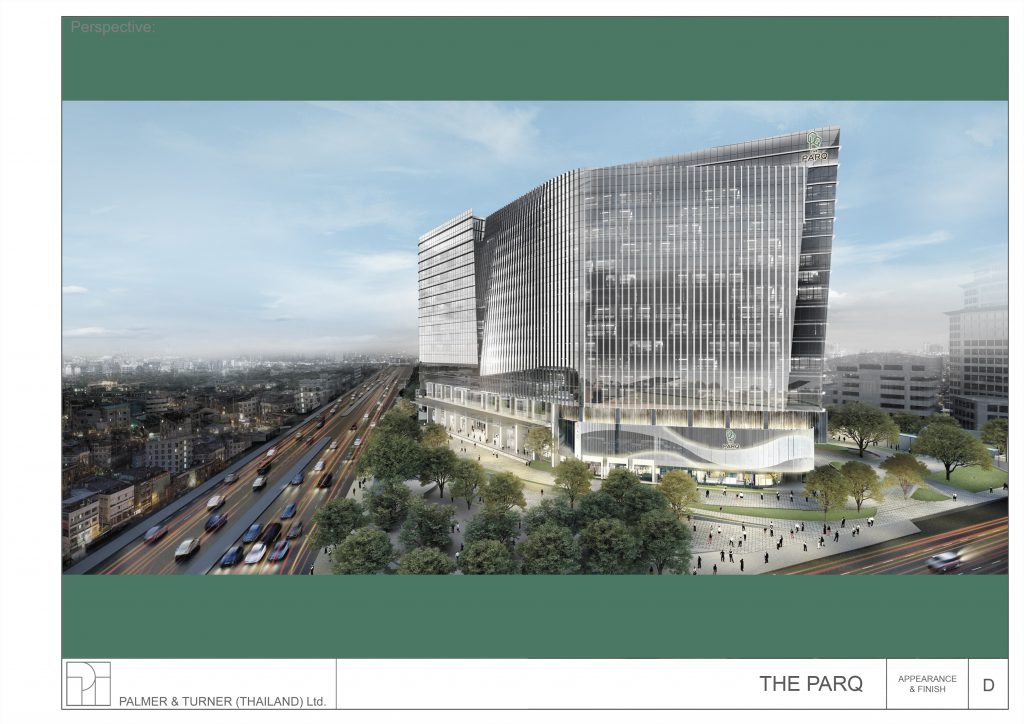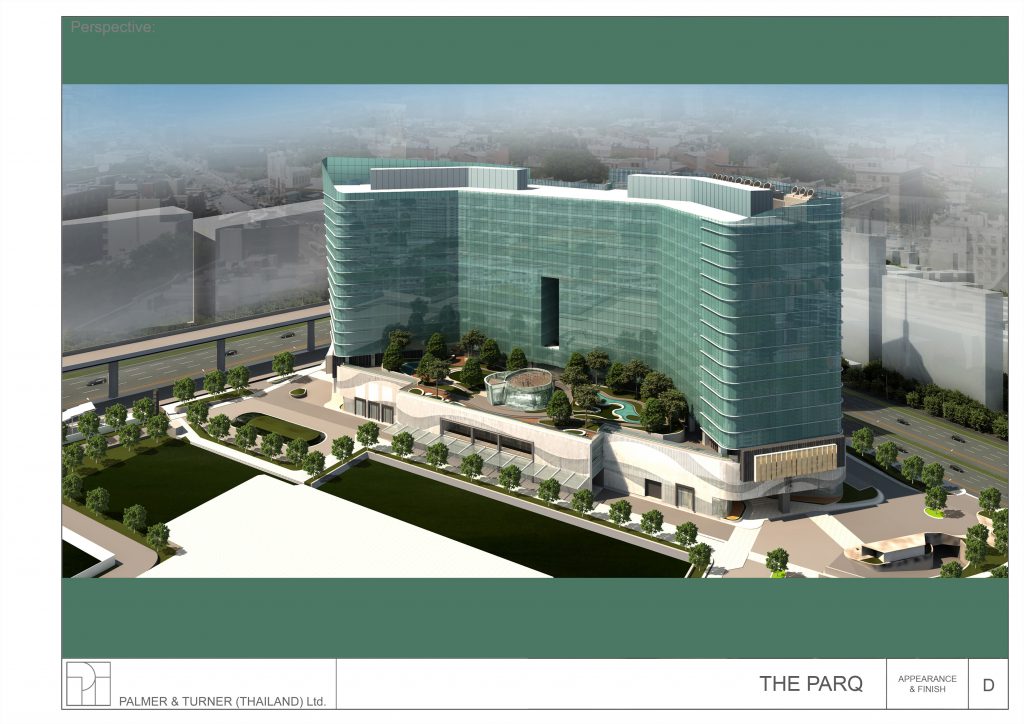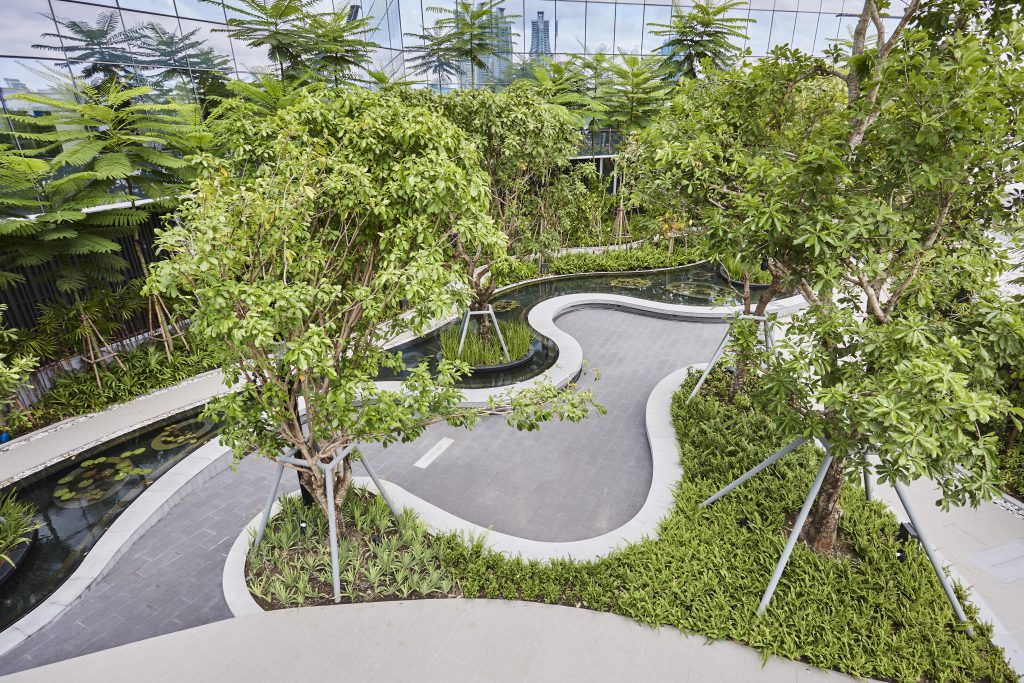This large-scale mixed-use project is a perfect example of how the design solutions resolve the issues of glass curtain walls and eventually achieve the goal to become a LEED-certified building.
Text: Jaksin Noyraiphoom
Photo Courtesy of Frasers Property Holdings (Thailand) Co., Ltd.
Download the online journal Issue 03 Seeing Through Click here
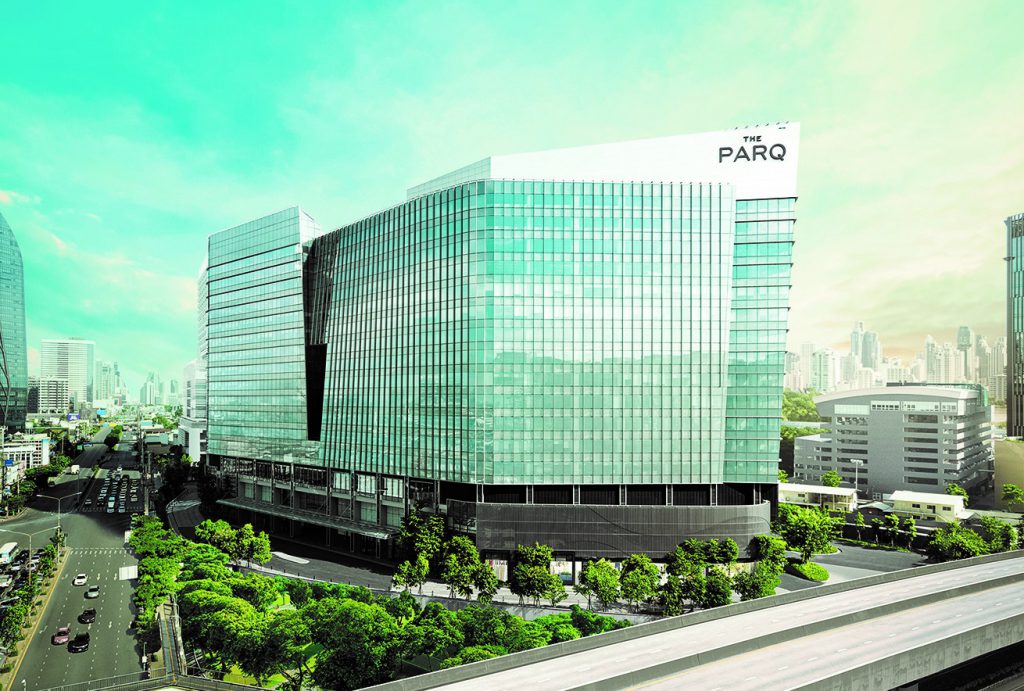
หากเปรียบสถาปัตยกรรมดั่งร่างกายของคน ผนัง ย่อมเปรียบได้กับเสื้อผ้า ซึ่งมีหน้าที่ปกป้องร่างกายจากสภาพแวดล้อมและอันตรายภายนอก ในแง่มุมด้านสุนทรียภาพ ผนังอาคารยังทำหน้าที่คล้ายเสื้อผ้า ในการสะท้อนบุคลิกและตัวตนของผู้ที่สวมใส่ ผนังจึงเป็นองค์ประกอบที่สำคัญมากในการออกแบบงานสถาปัตยกรรม เพื่อสื่อสารตัวตนและสาส์นบางอย่างของอาคารนั้นๆ ไปยังผู้ที่พบเห็น โดยหนึ่งในวัสดุยอดนิยมลำดับต้นๆ ที่สถาปนิกในสมัยนี้มักเลือกมาเป็นอาภรณ์ห่มสถาปัตยกรรมนั่นคือ กระจก เนื่องจากเป็นสัญลักษณ์ที่แสดงถึงความทันสมัย มีความเรียบง่าย สามารถก่อสร้างได้ง่าย มีน้ำหนักเบาเมื่อเทียบกับวัสดุชนิดอื่นๆ ในมิติด้านการใช้งาน ผนังกระจกยังให้ความรู้สึกโปร่ง เบา ผู้ที่อยู่ภายในอาคารสามารถรับแสงสว่างและมุมมองจากภายนอก ช่วยให้ผู้ที่อยู่ภายในไม่รู้สึกว่าถูกปิดกั้นจากสภาพแวดล้อมโดยรอบ ผนังกระจกจึงถือเป็นวัสดุที่ตอบโจทย์สถาปัตยกรรมสมัยใหม่ได้ดี
หากแต่ปัญหาที่อาคารซึ่งใช้ผนังกระจกส่วนใหญ่มักพบเจอนั่นคือ ความร้อนจากภายนอกมีโอกาสเข้ามาในอาคารมากกว่าผนังประเภทอื่น ซึ่งจะมีผลโดยตรงต่อการประหยัดพลังงานของอาคาร ทำให้ต้องมีการแก้ปัญหาดังกล่าว โดยเฉพาะอย่างยิ่งในยุคที่ประเด็นด้านการอนุรักษ์สิ่งแวดล้อมและการใช้พลังงานอย่างประหยัด มีสถานะคล้ายกฎข้อบังคับ ที่ผู้ออกแบบทุกคนจำเป็นที่ต้องปฏิบัติตาม โดยไม่สามารถหลีกเลี่ยงได้ และในบรรดาอาคารสมัยใหม่ที่ใช้ผนังกระจกนี้ The PARQ ถือเป็นโครงการที่เป็นตัวอย่างของการแก้ปัญหาดังกล่าวได้เป็นอย่างดี
The PARQ เป็นโครงการมิกซ์ยูสขนาดใหญ่ที่มุ่งพัฒนาสำนักงานและรีเทลอัจฉริยะ ตั้งอยู่บริเวณหัวมุมถนนรัชดาภิเษก ตัดกับถนนพระราม 4 ใกล้กับศูนย์การประชุมแห่งชาติสิริกิติ์ บนพื้นที่โครงการ 24 ไร่ พื้นที่ใช้สอยอาคารรวม 320,000 ตารางเมตร ตัวโครงการได้รับการออกแบบภายใต้แนวคิด Life Well Balanced หรือการใช้ชีวิตอย่างสมดุล ผ่านการออกแบบและโปรแกรมต่างๆ ที่ให้ความสำคัญต่อการมอบคุณภาพชีวิตที่ดีขึ้นให้แก่พนักงานของบริษัทผู้เช่าภายในโครงการและผู้มาเยือน พร้อมกับความใส่ใจในด้านสิ่งแวดล้อมเป็นสำคัญ
ภายในโครงการ The PARQ ประกอบไปด้วยพื้นที่ใช้งาน 2 ส่วนหลัก ได้แก่ พื้นที่สำนักงาน ที่เรียกว่า ‘The PARQ Workplace’ และพื้นที่ร้านค้า ในชื่อ ‘The PARQ Life’ โดยส่วนของ The PARQ Workplace นั้นประกอบด้วยอาคารสำนักงานสูง 16 ชั้น พื้นที่ใช้งาน 60,000 ตารางเมตร แบ่งออกเป็น 2 อาคาร เชื่อมต่อกันในส่วนชั้นบน ภายในพื้นที่สำนักงานได้รับการออกแบบให้ปราศจากเสา (column-free) ทำให้มีพื้นที่ใช้งานที่ยืดหยุนและกว้างขวางและเน้นระบบสำนักงานอัจฉริยะ ในส่วนของ The PARQ Life ประกอบด้วย พื้นที่ร้านค้าปลีกระดับพรีเมียม 12,000 ตารางเมตร เป็นแหล่งรวบรวมร้านค้า ร้านอาหาร และบริการ ครบวงจร โดยเน้นไปที่สินค้าและบริการเพื่อสุขภาพ ร้านค้าที่ดำเนินธุรกิจอย่างรับผิดชอบต่อสังคมและสิ่งแวดล้อม

“แนวคิดในการออกแบบอาคารนี้คือ หยิน-หยาง ซึ่งหมายถึง สิ่งที่เป็นขั้วตรงข้ามกัน แต่รวมกันแล้วเกิดพลัง ซึ่งเราก็จะเอามาประยุกต์ในหลายๆ ส่วน ทั้งการวางผังอาคาร รูปร่างอาคาร หรือในส่วนของผนัง”
ชาญศาสตร์ พิมพ์กำเนิด หนึ่งในทีมสถาปนิกผู้ออกแบบจาก Palmer & Turner (ประเทศไทย) กล่าวถึงแนวคิดในการออกแบบสถาปัตยกรรมของ The PARQ ที่พัฒนาต่อยอดมาจากแนวคิดเบื้องต้นของทางโครงการ
จากแนวคิด หยิน-หยาง ผู้ออกแบบได้นำมาตีความและสื่อสารผ่านการออกแบบ ทั้งผังของตัวอาคารที่มีลักษณะเป็นอาคารสองหลังวางอยู่ด้วยกัน มีการออกแบบผนังบางส่วนให้บิดโค้ง คล้ายกับสัญลักษณ์ของ หยิน-หยาง ผู้ออกแบบยังได้แทรกพื้นที่ธรรมชาติและพื้นที่สีเขียวไว้ในส่วนต่างๆ เช่น สวน Q Garden สวนลอยฟ้าขนาด 3,400 ตารางเมตร บริเวณชั้นดาดฟ้าโพเดียม รวมทั้งพื้นที่สีเขียวและพื้นที่กลางแจ้งอีกกว่า 7,000 ตารางเมตร แทรกอยู่ในพื้นที่ต่างๆ ทั่วทั้งโครงการ สะท้อนถึงความเป็นสถาปัตยกรรมสมัยใหม่ ที่มีความสมดุลระหว่างความทันสมัยกับความเป็นธรรมชาติ
นอกจากนี้ยังมีโจทย์ที่สำคัญอีกอย่างที่ท้าทายผู้ออกแบบคือ โครงการนี้ตั้งเป้าไว้ว่าจะเป็นอาคารที่ได้รับการรับรองมาตรฐานเกณฑ์การประเมินความยั่งยืนของ LEED ผนังของอาคารจึงเป็นหัวใจสำคัญในการช่วยสร้างให้เกิดความยั่งยืนภายในอาคาร สถาปนิกจึงออกแบบผนังโดยรอบของอาคารโดยคำนึงถึงทิศทางของแดด และมีการออกแบบแผงกันแดดที่แตกต่างกันไปในแต่ละด้าน สัมพันธ์กับแสงแดดที่เข้ามาในแต่ละทิศทาง ผนังฝั่งด้านทิศตะวันตกและทิศใต้ของอาคารซึ่งเป็นทิศที่ต้องรับแดดและความร้อนมากที่สุดจะใช้แผงกันแดดแนวนอน ในส่วนของผนังด้านทิศตะวันออกที่ได้รับแดดรองลงมาจะเป็นแผงกันแดดแนวตั้ง และผนังด้านทิศเหนือซึ่งตามปกติได้รับแดดน้อย จะใช้เฉพาะกระจกไม่มีแผงกันแดด ผนังภายนอกส่วนใหญ่เป็นกระจก จึงได้ติดตั้งกระจกกรองแสงสามชั้น ที่มีคุณสมบัติสามารถกันความร้อนจากแสงแดดได้ถึง 75% และแสงธรรมชาติสามารถผ่านเข้ามาได้ ช่วยลดความร้อนมากถึง 25% ผนังกระจกที่มีความโปร่งนี้ช่วยให้ผู้ที่อยู่ภายในอาคารได้รับแสงสว่างและทิวทัศน์จากโดยรอบ ช่วยให้ไม่ตัดขาดตัวเองจากภายนอก ภายในอาคารยังมีระบบเปิด-ปิดไฟอัตโนมัติ LED Panel สามารถปรับระดับความสว่างของแสงไฟได้อัตโนมัติเมื่อมีแสงธรรมชาติเพียงพอ ซึ่งประหยัดพลังงานได้มากกว่า 50% เมื่อเทียบกับระบบไฟตามมาตรฐานทั่วไป
โครงการ The PARQ ยังได้รับการออกแบบและสร้างขึ้นตามเกณฑ์การประเมินมาตรฐานทางสุขภาวะ WELL Building Standard ซึ่งเป็นมาตรฐานแรกของโลกที่ให้ความสำคัญกับคุณภาพชีวิตของผู้อยู่อาศัยและผู้ใช้อาคาร โดยคำนึงถึงหัวใจสำคัญด้านสุขภาวะของผู้ใช้อาคาร ซึ่งผนังกระจกมีส่วนสำคัญอย่างมากเช่นกัน ทั้งการป้องกันความร้อน ช่วยให้ผู้ใช้อาคารเกิดความรู้สึกน่าสบาย แสงสว่างจากธรรมชาติที่ส่องเข้ามาภายใน ทำให้ทุกพื้นที่ทำงานได้รับแสงสว่างในระดับที่เหมาะสม ผนังกระจกยังมีความโปร่งใส ช่วยให้ผู้ที่อยู่ภายในสามารถทอดสายตามองออกไปยังพื้นที่สีเขียวที่อยู่ภายนอกอาคารได้ ช่วยสร้างบรรยากาศที่ร่มรื่น เพื่อให้ผู้ใช้งานภายในอาคารมีสุขภาพจิตใจที่ดี ผสานกับระบบต่างๆ ที่ช่วยส่งเสริมสุขภาพและคุณภาพชีวิตของผู้ใช้อาคาร

ความท้าทายอีกประการในการออกแบบผนังกระจกของอาคารหลังนี้ คือผนังกระจกในส่วนที่มีการบิดโค้ง ทำให้ต้องมีการทดลองใช้เทคนิคพิเศษในการดัดกระจกให้โค้ง ที่เรียกว่า Cold-Bent ซึ่งเป็นการดัดกระจกให้โค้งโดยไม่ใช้ความร้อน ด้วยการปรับเฟรมของกระจกให้บิดออกจากระนาบเดิมเล็กน้อย ถือเป็นเทคนิคใหม่ที่ทางผู้ออกแบบได้ทดลองนำมาใช้ในโครงการนี้เป็นแห่งแรก ทำให้ได้ประสบการณ์และองค์ความรู้ใหม่ที่ได้เรียนรู้จากการออกแบบผนังของอาคารหลังนี้ นอกจากนี้ยังมีการเตรียมพื้นที่บนดาดฟ้าของอาคารไว้ เพื่อรองรับระบบดูแลรักษาและทำความสะอาดกระจกจากภายนอกอาคาร
ในการออกแบบและบริหารจัดการอาคาร The PARQ ที่ให้ความสำคัญกับระบบสำนักงานและรีเทลอัจฉริยะไปพร้อมกับการยกระดับคุณภาพภายในอาคารให้ปลอดภัยและส่งเสริมสุขภาวะผู้ใช้งานอาคาร จึงนำนวัตกรรมต่างๆ มาปรับใช้ควบคู่กับการพัฒนาโครงการที่ตอบรับการใช้งานอาคารในยุคชีวิตวิถีใหม่ เช่น การติดตั้งหลอด UVC ตรงมือจับราวบันไดเลื่อนขึ้นลงในส่วนของรีเทล ระบบกรองอากาศสองชั้นเพื่อป้องกันฝุ่น PM2.5 และ PM10 และการติดตั้งหลอด UVC Emitters เพื่อช่วยเพิ่มประสิทธิภาพการเปล่งรังสีที่มีความเข้มสูง สามารถกำจัดแบคทีเรีย เชื้อรา ลดการแพร่กระจายของเชื้อโรคต่างๆ ที่ติดต่อผ่านทางอากาศ นอกจากนี้ยังมีการพัฒนา The PARQ application โดยที่พนักงานในอาคารสามารถใช้ QR Code เฉพาะของแต่ละบุคคลสำหรับการเข้าออกภายในพื้นที่ส่วนต่างๆ ของโครงการ รวมถึงพื้นที่จอดรถ การใช้งานลิฟต์โดยสารการเข้าสู่อาคารสำนักงาน หรือระบบตรวจจับใบหน้าอัตโนมัติ (Facial recognition) สำหรับพนักงานในอาคาร เพื่อสร้างความปลอดภัยผ่านระบบไร้สัมผัส ตลอดจนการเตรียมพื้นที่สถานีอัดประจุรถยนต์ไฟฟ้า (EV charging stations) เพื่อตอบรับเทรนด์ของยานยนต์ไฟฟ้าที่จะเพิ่มมากขึ้นในอนาคต
จากแนวคิดการพัฒนาและออกแบบอาคารที่ให้ความสำคัญกับการลดผลกระทบต่อสิ่งแวดล้อมและธรรมชาติ ตลอดจนส่งเสริมสุขภาพและคุณภาพชีวิตของผู้ใช้งานในอาคารไม่ยิ่งหย่อนไปกว่ากัน จึงส่งผลให้ The PARQ เป็นโครงการรูปแบบผสมผสาน (Mixed-Use) โครงการแรกของประเทศไทยที่ได้รับการรับรองมาตรฐานอาคารเขียว LEED ในระดับ Gold Version 4 – LEED v4 BD+C: (LEED version 4 Building Design and Construction) Core and Shell certification และยังผ่านเกณฑ์การประเมินของ WELL Building Standard ที่ให้ความสำคัญกับคุณภาพชีวิตของผู้ใช้งาน อีกทั้งโครงการยังคำนึงถึงการออกแบบอาคารในยุคชีวิตวิถีใหม่ (New Normal) ถือเป็นต้นแบบของสถาปัตยกรรมในอนาคต ที่นอกจากจะต้องตอบโจทย์ทางด้านธุรกิจแล้ว ยังต้องคำนึงถึงสิ่งแวดล้อม สังคม และสุขภาพของผู้ใช้งานควบคู่กันไป
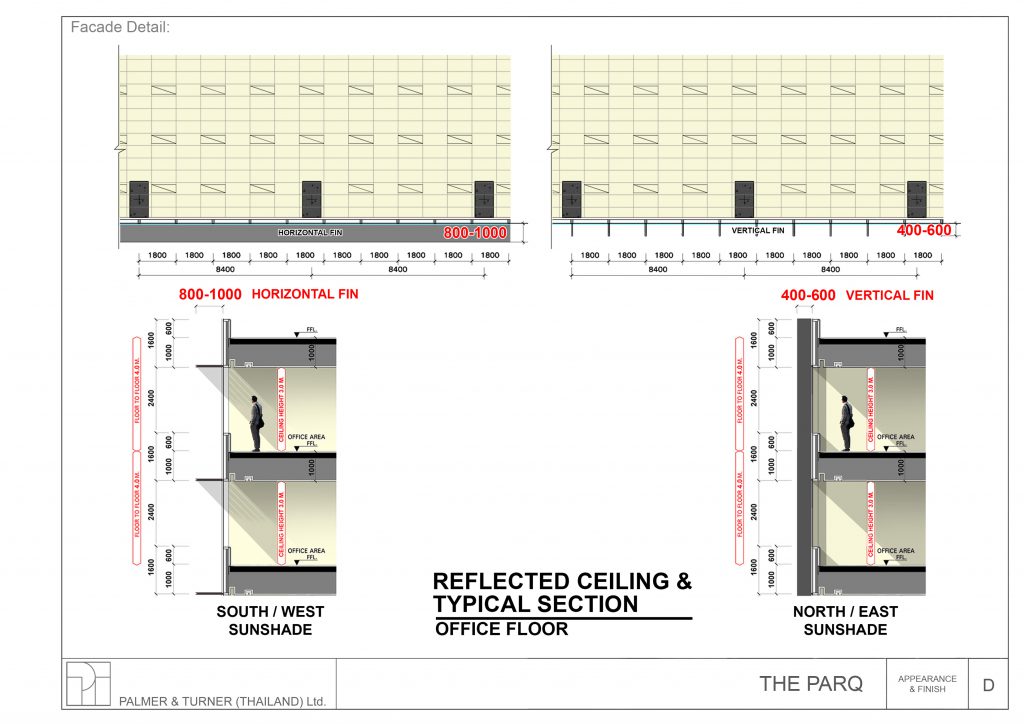
Glass has become one of the most favored materials that today’s architects choose to utilize for the architectural structures they create. Glass symbolizes modernity and simplicity. It’s easy to construct and physically lighter compared to other construction materials used for the same functional purpose. It also holds more dimensional functionalities while providing greater spaciousness, weightlessness and exposing building users to more sunlight and a view outside. Thus, keeping a living or functional space from being too enclosed or confined. With all of the aforementioned, glass walls are considered one of the materials that can fulfill both aesthetic and functional requirements of modern architecture.
One of the downsides that come with glass walls is the chance of outside heat penetrating the building’s interiors. The chances of this occurring is relatively higher than the use of other construction materials. The direct effect this problem has on the building’s energy saving performance requires an efficient solution, particularly during the time when environmental and energy conservation has become something close to a regulation that architects need to unavoidably comply with. Among modern buildings with a vigorous use of glass walls, The PARQ stands out as a perfect example that displays how design solutions have been created to resolve the heat issue that comes with curtain walls.
The PARQ is a large-scale mixed-use project developed to be a smart office and retail space. Situated on the corner of Ratchadapisek and Rama 4 Road, near Sirikit National Convention Center, on the expansive 9.48-acre land with the total functional space of 320,000 square meters, the project is materialized from the ‘Life Well Balanced’ concept. Architectural and interior programs were created with an aim to offer a better quality of life through environmentally conscious design to the office workers of tenants who rent the space or to visitors in general.
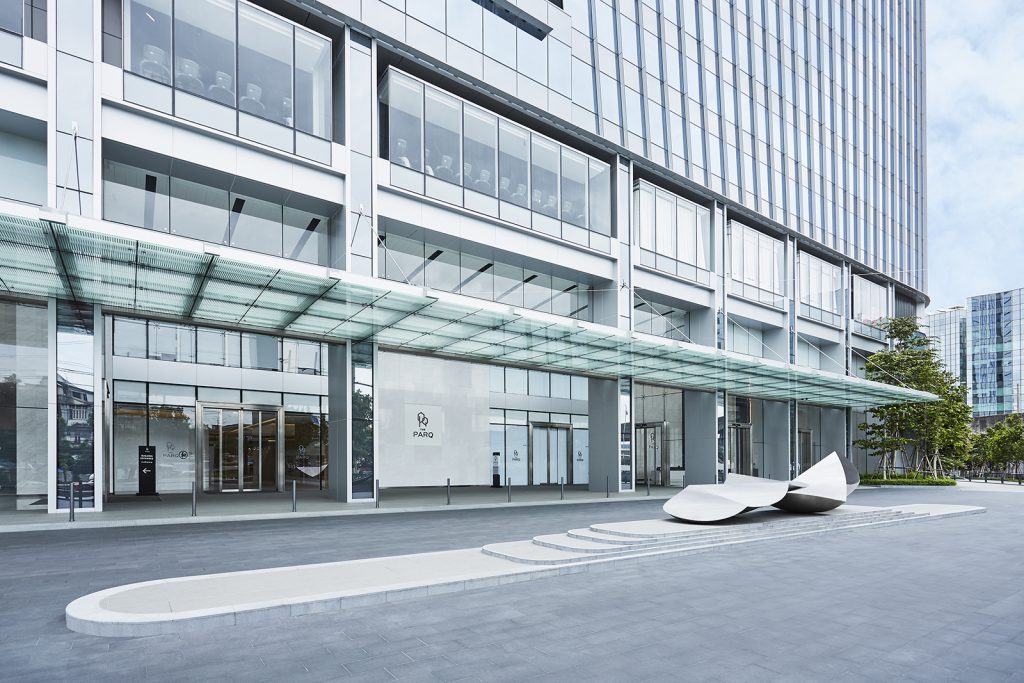
The PARQ comprises of two main functional programs; the office space or ‘The PARQ Workplace’ and the retail spaces referred to as ‘The PARQ Life.’ The PARQ Workplace is home to the 16-story office building and 60,000 square meters of functional spaces, which are divided into two buildings with the upper floors connected. Inside, each unit of column-free office space offers greater flexibility and spaciousness, and is also operated as a smart office. The PARQ Life consists of 12,000 square meters of premium retail spaces, housing a comprehensive range of establishments from shops to restaurants, providing products and services that are not only health conscious but also operated with environmental awareness to benefit society.
“The design concept is essentially following the Yin-Yang philosophy; the two opposite counterparts or elements that complement and empower each other. We apply that to many parts of the design, from floor plan layout, the physical appearance of the building as well as to the walls,” Chansart Pimkamnerd, one of the architects from the design team of Palmer & Turner (Thailand), talks about the primary concept that began to originate The PARQ’s architectural design.
From the idea of Yin Yang, the design team interprets and conveys the philosophy through the design of the building’s layout, which houses two built structures each of partially curved walls that mimic the Ying-Yang symbol. The design team also includes natural elements and green spaces in different parts of the building such as the Q Garden, which is a 3,400-square meter rooftop garden on the Rooftop Podium zone, while other outdoor areas and green spaces tally up to 7,000 square meters and find their ways to various parts of the project. The approach reflects the concept behind modern architecture that fosters a balance between modernity and nature.
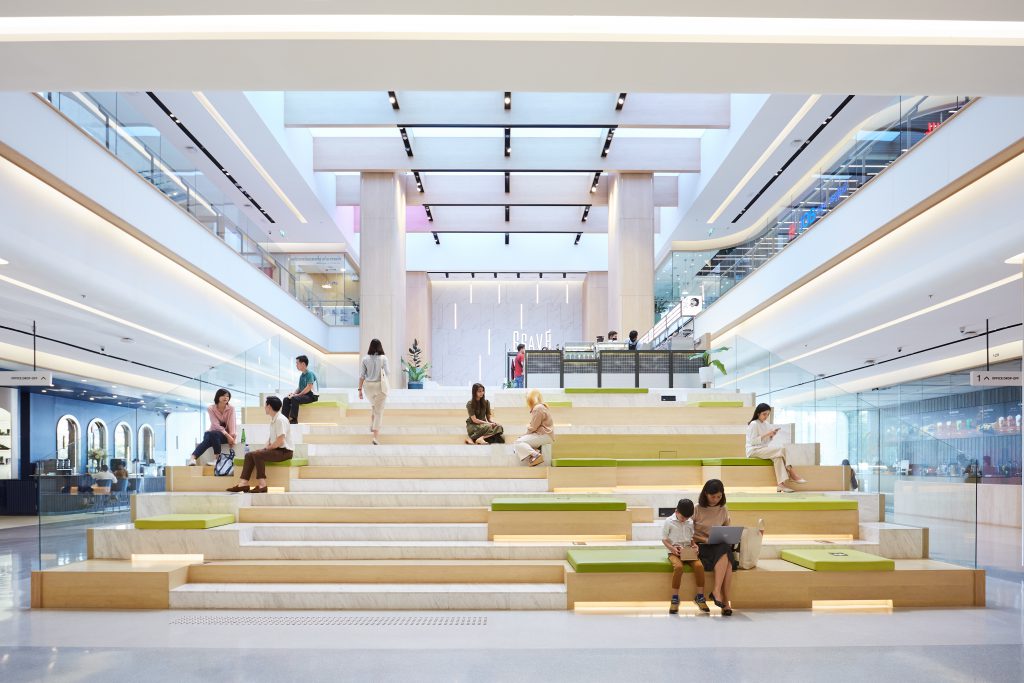
Another challenge the design team had to overcome is the project’s goal to become a LEED-certified building. The building’s walls became one of the key compositions that would help the design attain its sustainability goal. The architecture team had to design the walls while taking great consideration in the directions of sunlight, which also determine the various designs of sun protection panels installed on different sides of the building, corresponding with the natural brightness of the sun’s ray. The walls facing the west and south side are equipped with horizontal panels for they are the most exposed to sunlight and radiating heat. The vertical panels are installed on the east-facing side where the sun is less intense. The panels are absent from the north-facing wing where curtain walls are already sufficient due to minimal sun exposure. The design team specifically chooses the triple glaze glass for the curtain walls, which serve as the majority of the building’s exterior shell with the ability to filter up to 75% of the heat from sun’s ray, and reduce as high as 25% of heat entering the building while still allowing natural light to come through. The walls’ transparent feature brings spaciousness and access to the right amount of natural light and outside view, keeping the interior spaces connected to the surrounding environment. Additionally, the building is equipped with an automatically operated LED Panel, which adjusts artificial light according to the amount of natural light inside the interior spaces, consequentially saving 50% more power compared to a standard lighting system.
The PARQ is also designed and constructed according to the WELL Building Standard’s criteria, the world’s first building standard focused exclusively on human health and wellness. Glass walls play a significant role in preventing heat, providing users with thermal comfort and sufficient amount of natural light while granting every functional space with the perfect level of brightness. The transparent glass walls grant users access to the outside green spaces whose presence is incorporated into the interiors, keeping the functional program pleasant with natural elements of growing trees, and simultaneously keeping the building’s users emotionally healthy. The walls work in tandem with other functional systems of the architecture and interiors, which results in the overall improvement of users’ physical well-being and quality of life.
Another challenge in the design of the curtain walls for this project are the curvy parts, which require the design team to experiment on a process called cold-bending, where the glass is bent into the desired curve without using any heat but by adjusting the frame to slightly deviate from its original plane. Through utilizating this particularly new technique for the first time with this project, the design team ends up learning a new aspect about curtain wall design. Additionally, a service area is provided on the rooftop to accommodate the maintenance and cleaning of the curtain walls.
The design and management of The PARQ highlights the project’s ability as a smart office and retail spaces alongside the superlative quality and safety of interior spaces that offer users’ greater physical and mental well-being. Various innovations are incorporated to the project’s developmental approach to coincide with the spatial functionality in the New Normal era such as the installation of UVC tubes on the escalator’s handrails, the use of double-protection air purifying system to prevent PM2.5 and PM10, including the UVC Emitters to increase the release of high intensity UV rays that can eliminate microorganisms, fungi and minimize airborne contamination. Not only that, the development of The PARQ application allows each building’s user to create their own QR Code to enter and exit different parts of the program, including the parking space, elevators that lead directly to their office space, and facial recognition system that offers greater security and safety with the touch-less system. EV charging stations are also provided to accommodate the growing number of electrical vehicles in the future.
From the environmentally conscious development and design that also aims to improve human’s well being and quality of life, The PARQ has become Thailand’s first ever mixed use project to receive the Gold Version 4 – LEED v4 BD+C: (LEED version 4 Building Design and Construction) Core and Shell certification as well as achieving the WELL Building Standard. The project’s consideration to the New Normal lifestyle makes it an exemplary architecture of the future, developed not only to fulfill commercial goals, but one that also equally factors environmental and social issues as well as users’ physical and mental well being.


